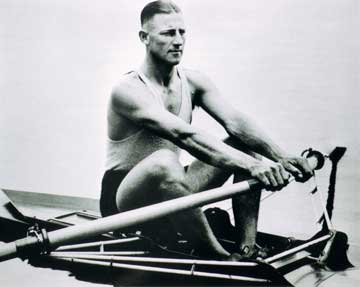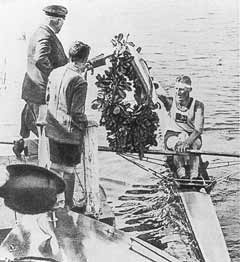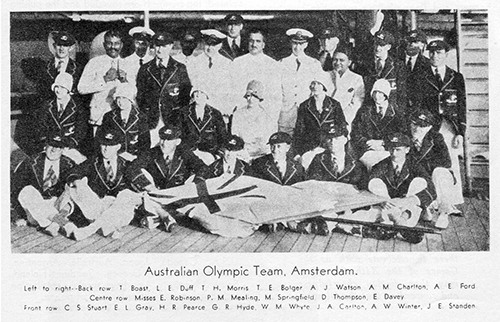Olympic Games—Amsterdam 1928
Selection
A small number of images of Bobby Pearce can be found through this link at the Australian Rowing Images website.
Bobby Pearce was Australia's only rowing representative at these Games. The 1927 Australian Amateur Rowing Council meeting resolved that in view "of the great expense and tremendous handicap an Australian eight oared crew is under by reason of the long journey involved in travelling to the Olympic Games as compared with other countries which compete, it is not considered advisable for the Commonwealth to be represented at the next Olympic Games by an eight oared crew. Further that all efforts be concentrated on preparing and sending a sculler to represent Australia provided a man of sufficiently high standard is forthcoming".

Henry "Bobby" Pearce
Mr Cecil L McVilly, our 1912 representative sculler, was appointed sole selector. A test race was conducted on the Lower Yarra in Melbourne over 2000 metres which was won by Pearce by six lengths in 7:24.0. Pearce became the Australian Olympic Federation's first choice, of all athletes, into the Olympic Team.
Pearce was given the honour of being the team's flag bearer. This was a good decision as he was the only gold medallist from Australia in any sport at these Games.
Pearce was a third generation sculling champion. He had hoped that after winning the Olympic gold, he might be able to race in the Diamond Sculls at Henley. He was refused permission because he was a carpenter. Back in Sydney he was out of work during the Depression when Lord Dewar, the Canadian whisky manufacturer, learned of Pearce's plight, he offered him a job as a salesman. Ironically, this new position allowed him to compete at Henley since he was no longer a labourer. In 1931 he won the Diamond Sculls by 6 lengths. Although he moved to Canada, he competed for Australia again in 1932 and won a second gold.

Gold Medallist Henry "Bobby" Pearce

Australian Team
Men's Single Scull – Gold
- Henry (Bobby) Pearce (NSW)
Sole Selector: Cecil McVilly (TAS)
Racing
The course choice caused controversy as it was the Stolen course which allowed only 2 crews to compete in each race. Furthermore the weather conditions caused lane advantages. It has been reported that repechages seemed to rectify any unusual heat results. It was also the first Olympic regatta with the full seven events that constituted the Olympic programme until 1976. Paul Costello of the USA won his third straight gold medal in the double scull, the first two with John Kelly Snr.
Men's Single Scull
Elimination Heats
E1: 1st. GBR 2nd. SUI
E2: 1st. AUS 2nd. GER
E3: 1st. CAN 2nd. NED
E4: 1st. FRA 2nd. BEL
E5: 1st. HUN 2nd. DEN
E6: 1st. USA 2nd. AFS
E7: 1st. TCH 2nd. JPN
E8: 1st. ITA
Repechages
R1: 1st. DEN 2nd. GER
R2: 1st. NED 2nd. BEL
R3: 1st. SUI 2nd. SAF
Second Round Heats
2E1: 1st. NED 2nd. HUN
2E2: 1st. TCH 2nd. CAN
2E3: 1st. AUS 2nd. DEN
2E4: 1st. USA 2nd. GBR
2E5: 1st. FRA 2nd. ITA
2E6: 1st. SUI
Second Round Repechage
2R1: 1st. CAN 2nd. ITA
2R2: 1st. GBR 2nd. HUN
Quarter Finals
QF1: 1st. GBR 2nd. CAN
QF2: 1st. NED 2nd. TCH
QF3: 1st. USA 2nd. SUI
QF4: 1st. AUS 2nd. FRA
Semi Finals
SF1: 1st. AUS 2nd. GBR
SF2: 1st. USA 2nd. NED
Finals
Final 1: 1st Henry Pearce (AUS) 7:11.0, 2nd Kenneth Myers (USA) 7:20.8
Final 2 for 3rd place: 3rd Theodore Collet (GBR) 7:29.8, 4th Lamertus
Gunther (NED) 7:31.6 (15 scullers)
In his first race, Pearce defeated the German champion by 12 lengths. In his second race he defeated the Danish sculler by 8 lengths. In the quarter final, he defeated the French sculler by 20 lengths and took 3 seconds off the course record despite resting his oars to avoid hitting a duck and ducklings mid stream. In the semi final he was pushed for the first time by the British sculler Collet and won only by 3/4 lengths in 7:01.8 – a course record. The final was also won comfortably by 8.2 seconds defeating Kenneth "Wally" Myers of the USA. Some reports merely stated that Pearce outclassed his opponents.
Other Racing
Men's Double Scull
1st USA (Paul Costello & Charles McIlvaine) 6:41.4, 2nd CAN 6:51.0, 3rd AUT 6:48.8 (10 crews) [NB: because there were 2 crew finals, and the 3rd placing was determined by a second final race. The time for the third placed crew is faster than the second placed crew.]
Men's Coxless Pair
1st GER (Bruno Muller & Kurt Moschter) 7:06.4, 2nd GBR 7:08.6, 3rd USA 7:20.4 (8 crews from 8 nations)
Men's Coxed Pair
1st SUI (Hans Schochlin, Karl Schochlin and Hans Bourquin) 7:42.6, 2nd FRA 7:48.4, 3rd BEL (6 crews)
Men's Coxless Four
1st GBR (Trinity College Cambridge - John Lander, Michael Warriner, Richard Beesly, Edward Vaughan Bevan) 6:36.0, 2nd USA 6:37.0, 3rd ITA 6:37.6 (6 crews)
Men's Coxed Four
1st ITA (Valerio Peretin, Giliante D'Este, Nicolo Vittori, Giovanni Delise, Renato Petronio), 6:47.8, 2nd SUI 7:03.4, 3rd POL 7:12.8 (11 crews)
Men's Eight
The eights racing was notable because the American cox had a raised seat to better look down at the crew and shout orders. He did everything to annoy the other crews including bashing the sides of the boat with his toggles, shouting abuse and waving a white scarf about his head. The New York Times correspondent described the behaviour as "one of the greatest performances of demoniacal howling ever heard on a terrestrial planet . . . He gave the impression of a terrier suddenly gone mad. But such language and what a vocabulary!"
1st USA (Marvin Stalder, John Brinck, Francis Frederick, William Thompson, William Dally, James Workman, Hubert Caldwell, Peter Donlon, Donald Blessing) 6:03.2,
2nd GBR 6:05.6, 3rd CAN 6:03.8 (11 crews) ) [NB: because there were 2 crew finals, and the 3rd placing was determined by a second final race. The time for the third placed crew is faster than the second placed crew].

